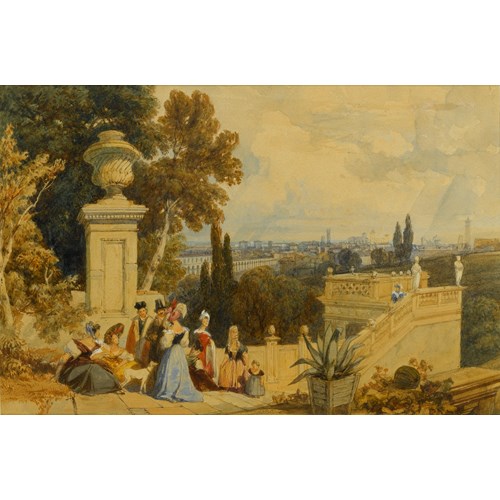Marketplace
St. Peter Penitent
Adriaen Thomasz. Key
St. Peter Penitent
Date 1564-1568
Period 1400-1600, 16th Century
Origin Belgium
Medium Oil on panel
Dimension 108.5 x 75.5 cm (42³/₄ x 29³/₄ inches)
The present painting is thought to be a very early example of the work of Adriaen Thomasz. Key, which demonstrates the wide variety of influences that the young artist incorporated into his narrative art. The composition is dominated by the figure of St. Peter, who crosses his arms and gazes to heaven. In the background are two vignettes from the Passion: Christ before Pilate, and the denial of St. Peter. However, this does not feel an overtly religious piece, rather a captivating and subtle portrayal of regret.
The present work dates to c. 1564-1568, when Key was still a member of Willem Key’s (c.1515/16–1568) workshop. It certainly relates to Willem, and their work is often hard to distinguish. However, details such as the dirt under the fingernail of St. Peter’s left thumb, suggests that the painting is from the hand of Adriaen. This small detail is absolutely typical of Adriaen who, as Koenraad Jonckheere explains, ‘explicitly presented saints - like Caravaggio would later also do - as very human, indeed, with dirt under their nails, and filthy, bare feet’.¹
There are two other versions of St. Peter Penitent, by Michel Coxcie I (1499-1592), which although inferior to the present in terms of quality, do demonstrate the significant impact Coxcie’s work had on Key’s development. Key probably came into contact with Coxcie whilst studying as a pupil of the glass painter Jan Hack.² The present work is not an isolated instance of Key copying Coxcie’s paintings. For example Key’s Cain and Abel (Zanchi Collection, Switzerland),³ is a copy of Coxcie’s treatment of the same subject in the Prado⁴. Much of Key’s understanding of Italian Renaissance principles seem to have derived from Coxcie’s art, and as Jonckheere remarks ‘Coxcie’s influence is clearest in Key’s juvenilia’.⁵ Therefore the present work seems to serve as a fascinating link between Adriaen Thomasz. Key, Willem Key, and Coxcie.
Adriaen Thomasz. was trained by Willem Key, and was a part of his workshop for many years. Traditionally it was thought that Adriaen was a relation of his master but it is now known that his family name was Thomasz. Adriaen only adopted the name Key after he took over his master’s workshop in 1568, because of the advantages of aligning his work with a long-established and successful painter. In effect ‘He thus used the name ‘Key’ to brand his art’.⁶
Although his art was firmly rooted in the tradition of Willem, Adriaen developed his own style, arguably surpassing the work of his master. Although he is justifiably considered one of the great Antwerp portraitists, a genre which makes up ninety percent of his preserved oeuvre, he also painted numerous religious scenes, such as the present example, in which he developed the pre-existing ideas of Willem, and Coxcie. However, after Calvinists took over the administration of Antwerp in 1579, production of altarpieces ceased, and the demand for mythological or devotional work must have been minimal.
¹ Jonckheere, K., Adriaen Thomasz. Key (c. 1545-c. 1589): Portrait of a Calvinist Painter (Brepols, Turnhout, 2007), p.41.
² Ibid., p.44.
³ Ibid., cat. no. A.103.
⁴ Inv. No. P01518
⁵ Jonckheere, p.44.
⁶ Jonckheere, K., ‘Supply and Demand: Some Notes on the Economy of Seventeeth-Century Connoisseurship’, in Art Market and Connoisseurship: A Closer Look at Paintings by Rembrandt, Rubens and their Contemporaries, ed. Tummers, A. & Jonckheere, K. (Amsterdam University Press, Amsterdam, 2008), p. 72.
The present work dates to c. 1564-1568, when Key was still a member of Willem Key’s (c.1515/16–1568) workshop. It certainly relates to Willem, and their work is often hard to distinguish. However, details such as the dirt under the fingernail of St. Peter’s left thumb, suggests that the painting is from the hand of Adriaen. This small detail is absolutely typical of Adriaen who, as Koenraad Jonckheere explains, ‘explicitly presented saints - like Caravaggio would later also do - as very human, indeed, with dirt under their nails, and filthy, bare feet’.¹
There are two other versions of St. Peter Penitent, by Michel Coxcie I (1499-1592), which although inferior to the present in terms of quality, do demonstrate the significant impact Coxcie’s work had on Key’s development. Key probably came into contact with Coxcie whilst studying as a pupil of the glass painter Jan Hack.² The present work is not an isolated instance of Key copying Coxcie’s paintings. For example Key’s Cain and Abel (Zanchi Collection, Switzerland),³ is a copy of Coxcie’s treatment of the same subject in the Prado⁴. Much of Key’s understanding of Italian Renaissance principles seem to have derived from Coxcie’s art, and as Jonckheere remarks ‘Coxcie’s influence is clearest in Key’s juvenilia’.⁵ Therefore the present work seems to serve as a fascinating link between Adriaen Thomasz. Key, Willem Key, and Coxcie.
Adriaen Thomasz. was trained by Willem Key, and was a part of his workshop for many years. Traditionally it was thought that Adriaen was a relation of his master but it is now known that his family name was Thomasz. Adriaen only adopted the name Key after he took over his master’s workshop in 1568, because of the advantages of aligning his work with a long-established and successful painter. In effect ‘He thus used the name ‘Key’ to brand his art’.⁶
Although his art was firmly rooted in the tradition of Willem, Adriaen developed his own style, arguably surpassing the work of his master. Although he is justifiably considered one of the great Antwerp portraitists, a genre which makes up ninety percent of his preserved oeuvre, he also painted numerous religious scenes, such as the present example, in which he developed the pre-existing ideas of Willem, and Coxcie. However, after Calvinists took over the administration of Antwerp in 1579, production of altarpieces ceased, and the demand for mythological or devotional work must have been minimal.
¹ Jonckheere, K., Adriaen Thomasz. Key (c. 1545-c. 1589): Portrait of a Calvinist Painter (Brepols, Turnhout, 2007), p.41.
² Ibid., p.44.
³ Ibid., cat. no. A.103.
⁴ Inv. No. P01518
⁵ Jonckheere, p.44.
⁶ Jonckheere, K., ‘Supply and Demand: Some Notes on the Economy of Seventeeth-Century Connoisseurship’, in Art Market and Connoisseurship: A Closer Look at Paintings by Rembrandt, Rubens and their Contemporaries, ed. Tummers, A. & Jonckheere, K. (Amsterdam University Press, Amsterdam, 2008), p. 72.
Date: 1564-1568
Period: 1400-1600, 16th Century
Origin: Belgium
Medium: Oil on panel
Dimension: 108.5 x 75.5 cm (42³/₄ x 29³/₄ inches)
More artworks from the Gallery









